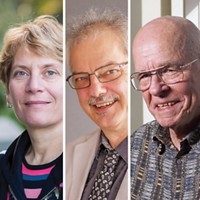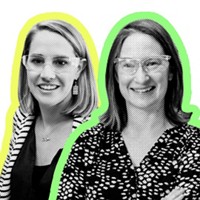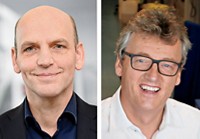Advertisement
Grab your lab coat. Let's get started
Welcome!
Welcome!
Create an account below to get 6 C&EN articles per month, receive newsletters and more - all free.
It seems this is your first time logging in online. Please enter the following information to continue.
As an ACS member you automatically get access to this site. All we need is few more details to create your reading experience.
Not you? Sign in with a different account.
Not you? Sign in with a different account.
ERROR 1
ERROR 1
ERROR 2
ERROR 2
ERROR 2
ERROR 2
ERROR 2
Password and Confirm password must match.
If you have an ACS member number, please enter it here so we can link this account to your membership. (optional)
ERROR 2
ACS values your privacy. By submitting your information, you are gaining access to C&EN and subscribing to our weekly newsletter. We use the information you provide to make your reading experience better, and we will never sell your data to third party members.
Catalysis
Podcast: Molecule-building tool wins Nobel Prize in Chemistry
Stereo Chemistry explores the science behind the 2021 Nobel Prize in Chemistry
by Kerri Jansen , Leigh Krietsch Boerner
October 6, 2021


The 2021 Nobel Prize in Chemistry went to Benjamin List and David W. C. MacMillan for their development of asymmetric organocatalysis, which has proved to be a powerful tool for building molecules. In this special episode of Stereo Chemistry, host Kerri Jansen, C&EN reporter Leigh Krietsch Boerner, and C&EN editorial fellow Emily Harwitz delve into the science behind the prize. Merck’s Rebecca Ruck also joins the Stereo Chemistry crew to weigh in on how organocatalysis has impacted drug development.
Read more about the 2021 Nobel Prize in Chemistry in Leigh Krietsch Boerner’s article on the prize.
Subscribe to Stereo Chemistry now on Apple Podcasts, Spotify, or wherever you get your podcasts.
The following is an edited transcript of the episode. Interviews have been edited for length and clarity.
Kerri Jansen: The 2021 Nobel Prize in Chemistry has gone to Benjamin List and David MacMillan for their development of asymmetric organocatalysis, which has proved to be a powerful tool for building molecules. The prize was announced in Stockholm on Oct. 6, and the Stereo Chemistry team has been working hard to bring you this special episode all about the winning science. We’ll start by exploring what asymmetric organocatalysis is, and then we’ll hear how the work of these two scientists has revolutionized how medicines are made.
I’m your host, Kerri Jansen. And joining me today in the Stereo Chemistry virtual studio is Emily Harwitz, C&EN’s editorial fellow.
Emily Harwitz: Hello!
Kerri: And Leigh Krietsch Boerner, who is C&EN’s reporter covering organic chemistry.
Leigh Krietsch Boerner: Hi Kerri, happy to be here.
Kerri: Welcome. A little bit later in the episode, we’ll hear from a drug development expert about the impact organocatalysis has had on that field. But before we get there, Leigh, let’s start with some background.
The Nobel Committee has chosen to honor Benjamin List and David MacMillan for their work on something called “asymmetric organocatalysis.” What is that?
Leigh: Right. So, asymmetric catalysis is when a chemist runs a reaction and uses a catalyst to preferentially make one enantiomer over another. If you need a refresher, enantiomers are like our hands—our left and right hands are mirror images of each other, but when you lay one on top of the other, they’re not superimposable.
Kerri: Right. I remember this.
Leigh: So enantiomers can behave differently from each other when they interact with chiral molecules, like the proteins and enzymes in our bodies that drugs often target. So being able to guide a reaction preferentially toward one enantiomer over another gives chemists more control over their product’s behavior.
But this is actually not the first time asymmetric catalysis has won a Nobel. In 2001, the committee awarded the chemistry prize to William Knowles, Ryoji Noyori, and Barry Sharpless for asymmetric catalysis using metal catalysts. Asymmetric organocatalysis, what this year’s award was for, uses an organic compound as opposed to a metal-containing one. It might sound like almost the same thing, but it’s actually pretty different.
Kerri: Got it. So we’re using an organic catalyst to preferentially make one enantiomer over another. And before chemists could use organic molecules as catalysts, prior to around 2000, they were often using either metals or enzymes to drive reactions, right?
Leigh: Right. For a long time, that’s where chemists’ knowledge stopped. List and MacMillan separately figured out how to use organic compounds to do the same types of reactions as the metal catalysts. List’s early work included using the amino acid L-proline to make chiral amino compounds. He later moved on to using Bronsted acids, molecules that donate a proton, as catalysts. MacMillan also worked with L-proline as a catalyst, but then expanded to using Lewis acids, compounds that can accept electrons. For example, he performed a Diels-Alder reaction with an iminium ion to make chiral alkenes.
Emily: And what’s the benefit of using organic molecules instead? I know heavy metals aren’t great for the environment; are organic molecules a more sustainable option?
Leigh: Yes, you’re right, Emily; they are in a way. A lot of transition metals can be toxic to people and the environment. Using organic molecules as catalysts means chemists aren’t making heavy metal waste that they later have to dispose of. Organic compounds are also generally easier to work with. Chemists typically don’t have to take special precautions to protect the catalysts from reacting with water or air. With all of these advantages, it’s no wonder asymmetric organocatalysis is so widely used now. And one of the fields asymmetric organocatalysis really had a huge impact on was drug discovery.
Kerri: Speaking of which, Emily and I sat down with Rebecca Ruck this morning to talk about the role of asymmetric organocatalysis in drug development. Becky works at Merck, where she leads a team that looks for the best ways to make drug molecules. She told us organocatalysis is an important tool in her toolbox.
Rebecca Ruck: There’s always been ways to make molecules, right? You can ram that square peg into a round hole, you can figure out how to make a molecule using chemistry that dates back to the 1800s. You know, if you do that, it might be a long and steppy synthesis, it might not be very efficient, you might generate a lot of waste. What organocatalysis has allowed us to do is to conceive of making molecules differently. That allows us to really circumvent some of these lengthy and inefficient processes.
Kerri: Becky told us that today, scientists use organic molecules to catalyze a huge range of reactions. And those developments were made possible by the template that Benjamin List and David MacMillan established in their seminal papers.
Rebecca Ruck: I think that was foundational. Just the fact that Macmillan and List got us thinking about how to use small molecules as organic catalysts—they’re so easy to make, they’re easy to diversify—I think provided us a really great resource to really target how to make molecules better.
Leigh: And remember, an important aspect of this chemistry is that organic molecules can be used to drive asymmetric reactions—meaning they produce only one version of two mirror-image molecules.
Emily: Yeah Becky mentioned that stereochemistry is important because compounds that are mirror images of each other can affect the body differently. She told us that without asymmetric organocatalysis, it’s a lot harder to isolate that single compound with the right orientation for a possible new medicine.
Rebecca Ruck: The problem with that is then you have both mirror images, and then you have to go in and separate them. And so at best, your yield drops by 50%. So I think you’d have a lot less productivity, a lot less accessibility of the molecules, and just all around a lot more waste as well.
Kerri: And those extra steps also drive up the price of the medicine. In contrast, asymmetric organocatalysis enables scientists to make just the single desired compound.
Emily: Becky gave us the example of Prevymis, a Merck drug that helps prevent infections of human cytomegalovirus, which is a common herpesvirus. In a person with a healthy immune system, it’s generally asymptomatic. But for immunocompromised people—including those who have had a bone marrow transplant—it can cause fatal health complications. The drug has been on the market since 2017.
Rebecca Ruck: The key transformation to set the stereocenter in Prevymis is made using organocatalysis. And so you can directly connect the fact that this field sort of had its genesis back in the early 2000s with us being able to deliver on that chemistry for something that we filed for approval in 2017. And it’s a really beautiful process to make it; it’s one of the greenest that we have, and really just allowed us to develop an asymmetric route that would allow us to make a lot more material to be able to treat a lot more patients.
Kerri: Thanks for joining us for this special episode of Stereo Chemistry. If you’d like to learn more about the Nobel winners and the winning science, check out Leigh’s story on C&EN’s website. We’ll include a link in this episode’s show notes.
This episode was written by me, Kerri Jansen, and Leigh Krietsch Boerner. Story editing by Michael Torrice. The episode was produced by Darren Weaver from ACS Productions. Production assistance by Emily Harwitz and Gina Vitale.
The music in this episode was “Ballerina” by Yehezkel Raz. Stereo Chemistry is the official podcast of Chemical & Engineering News, which is published by the American Chemical Society. Thanks for listening.





Join the conversation
Contact the reporter
Submit a Letter to the Editor for publication
Engage with us on Twitter